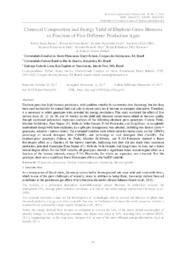Chemical composition and energy yield of elephant-grass biomass as function of five different production ages.
Chemical composition and energy yield of elephant-grass biomass as function of five different production ages.
Author(s): FREITAS, R. S.; BARBÉ, T. da C.; DAHER, R. F.; VIDAL, A. K. F.; STIDA, W. F.; SILVA, V. B. da; MENEZES, B. R. da S.; PEREIRA, A. V.
Summary: Abstract Elephant grass has high biomass production, with qualities suitable for conversion into bioenergy, but has long been used exclusively for animal feed and only in recent years has it become an energetic alternative. Therefore, it is necessary to select genotypes with potential for energy production. This study evaluated the effect of five harvest times (8, 12, 16, 20, and 24 weeks) on the yield and chemical composition related to biomass quality through combined polynomial regression analyses of the following elephant grass genotypes: Cubano Pinda, Mercker 86-México, Pusa Napier n°1, Mole de Volta Grande, P-241-Piracicaba, and King Grass. A completely randomized design with three replicates, in a split-plot arrangement, was adopted, including two factors (plots = genotypes, subplots = harvest times). The evaluated variables were whole-plant dry matter yield, in t ha-1 (DMY), percentage of neutral detergent fiber (%NDF), and percentage of acid detergent fiber (%ADF). The elephant-grass genotypes Cubano de Pinda, Mercker 86-México, and P-241-Piracicaba showed a linear first-degree effect as a function of the harvest intervals, indicating that they did not reach their maximum production potential. Genotypes Pusa Napier n°1, Mole de Volta Grande, and King Grass, in turn, had a linear second-degree effect. For the NDF variable, all genotypes showed a significant linear second-degree effect as a function of the harvest intervals, except P-241-Piracicaba, for which no regression was observed. For this genotype, there was a significant linear first-degree effect on the %ADF variable.
Publication year: 2018
Types of publication: Journal article
Unit: Embrapa Dairy Cattle
Observation
Some of Embrapa's publications are published as ePub files. To read them, use or download one of the following free software options to your computer or mobile device. Android: Google Play Books; IOS: iBooks; Windows and Linux: Calibre.
Access other publications
Access the Agricultural Research Database (BDPA) to consult Embrapa's full library collection and records.
Visit Embrapa Bookstore to purchase books and other publications sold by Embrapa.

